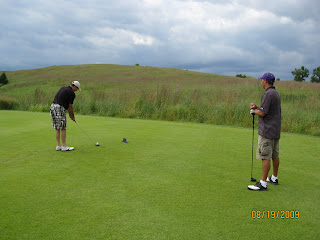
Tomorrow marks the start of yet another month gone by and with it usually cooler temperatures. In State College, temperatures are already decreasing with the highs only in the low to mid 70s. In Maryland, high temperatures are only getting into the low eighties, but the nighttime temps look to increase to near 70 by next week (once again if the weather reporters are correct which is usually a safe bet). Moving north to Westchester, NY and into New England, temperatures are set to be in the upper 70s and mid-70s, respectively. This means that diseases should start to subside and your interns have all headed back to school just in time to miss your fall core cultivation and leaf cleanup!
Disease activity continues to vary by region. Dollar spot continues to be a problem for most and is increasing for others. Brown patch is just about done and any new flare-ups will likely just be superficial and cause little real damage. One problem that has been a problem among superintendents managing Perennial ryegrass is gray leaf spot. This could continue to cause problems, especially where ryegrass is being overseeded into thinned areas (although you should have any thinned areas in this wet year). Another potential problem that was brought to my attention last week was the recurrence of an "unusual" Pythium patch problem on annual bluegrass. I don't have the time to get into this now, other than to say that it has been something I have been tracking for the past 4 years and seems to be a real problem for those that get it. It is a Pythium disease that selectively targets annual bluegrass with symptoms similar to summer patch. I plan to dedicate a full post to the subject next week, but for now if you think that you have summer patch on your annual bluegrass putting greens, consider sending a sample out to get checked for Pythium.
In the meantime, I thought that I would give some promotion of Dr. Pat Vittum's updates about grub and annual bluegrass problems in the Northeast. Pat is a GREAT resource for those of you in New England and was a tremendous supporter of my efforts while I was at UConn.
UMASS Update by Pat Vittum:
White grub development varies greatly from one location to another this year. Normally we would expect European chafers to emerge in mid-June and start laying eggs shortly thereafter. Oriental beetles usually are a week or two behind that, and then the Japanese beetle adults emerge around July 4th. But this year, perhaps because of cool soil temperatures, the Japanese beetle adults in particular were very...Read Full Story Here.
Annual bluegrass weevils. We are seeing activity and damage from the third generation in several locations from the metropolitan area up through Hartford. Based on our samples, most of the weevils are already large larvae or pupae, so the worst should be over. Now that the weather is breaking (lower temperatures and much lower humidity), the turf should be able to...Read Full Story Here.
OH, and one last thing...I am glad that I was not the only one who voted "No, this blog stinks". It appears that two others were in agreement with me. I just wonder if they two were blog authors or a golf course superintendent angry that there was no "PlayTurf" cover for August? Either way, it looks like most of you find the information useful so we plan to keep providing updates through the season! Thanks for all of your support and spread the word.























































